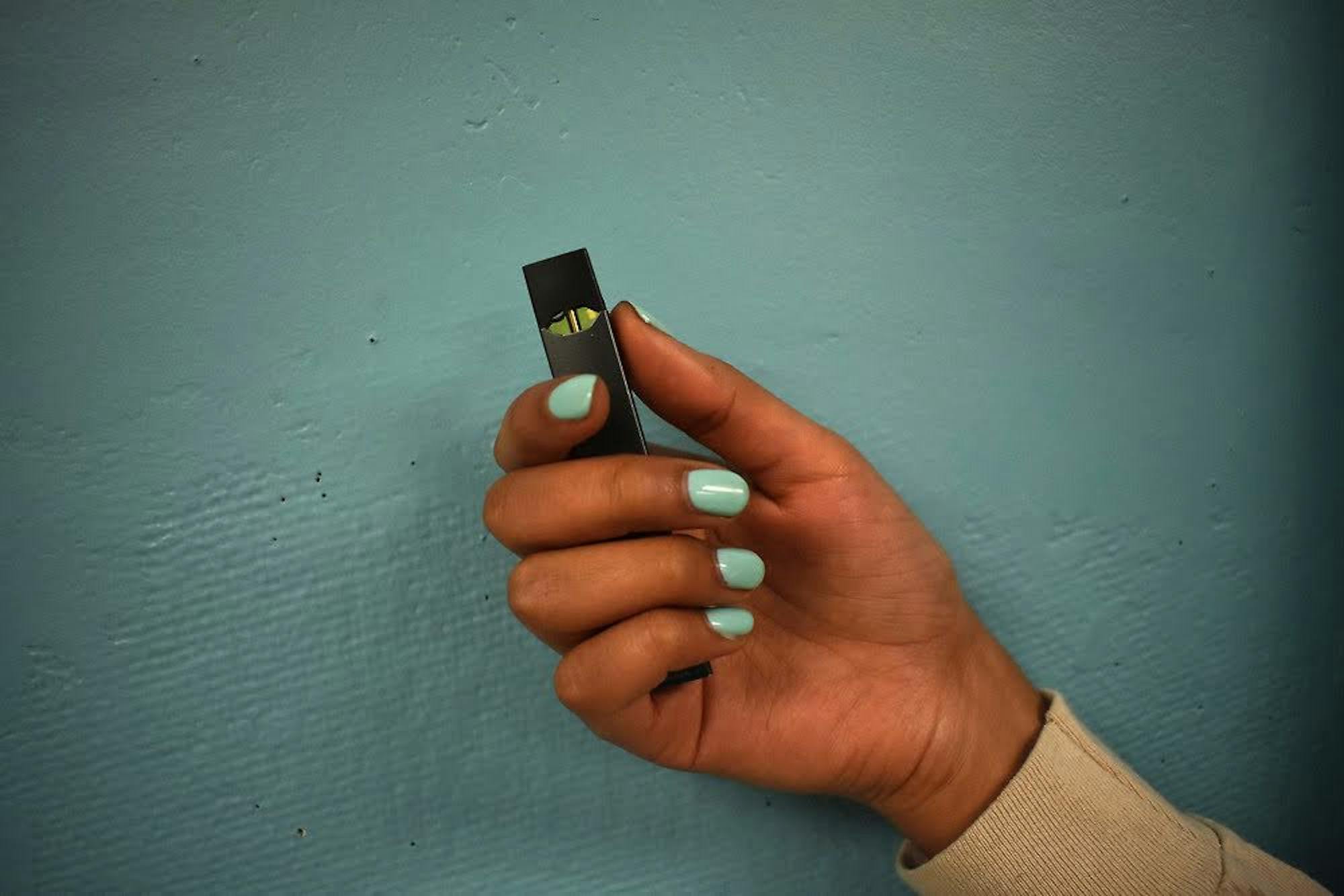Of late, the use of e-cigarettes has become more ubiquitous at Tufts, or at least it is perceived to be. A recent survey on vaping by the Daily asked 243 respondents to rate how common they think vaping is on campus on a scale of one to five, with five being “very common” — 57% rated either a four or five, with the average being a 3.6.
E-cigarettes, which stands for ‘electronic cigarettes’, are devices that produce aerosol from a liquid, often containing nicotine, flavorings and other chemicals, that users can then inhale. They come in many different designs, but commonly in the likeness of a skinny USB flash drive or a pen. The term "vaping" refers to the use of these devices.
According to the U.S. Surgeon General’s 2016 report on vaping among youth, vaping is linked to numerous health issues, including those caused by nicotine exposure or the inhalation of aerosol. The report also notes that little about the long-term effects of vaping is currently known.
With trends among middle and high schoolers on the rise, as indicated by the Surgeon General’s latest advisory on vaping, both a student-led initiative and the administration are paying more attention to the situation here at Tufts.
Situation at Tufts
In 2017, the Tufts Department of Health Promotion and Prevention oversaw the biennial National College Health Assessment II (ACHA-NCHA II) at Tufts, a survey on health and wellness designed by the American College Health Association. It found that out of the 855 Tufts undergraduates that responded, 89.6% of them had not used an e-cigarette before.
In contrast, of the 243 respondents to the Daily’s vaping survey, 132 (54.3%) have tried vaping and 45 (18.5 %) consider themselves active e-cigarette users.
When asked about the prevalence of vaping at Tufts today, Ian Wong, director of health promotion and prevention, explained that while the data that his department has collected so far through the ACHA-NCHA II reflects low e-cigarette usage among Tufts students, he has observed that more vaping has taken place on campus recently.
“Anecdotally, I hear that a lot of [Tufts] students do it. And just data-wise, if you look at the middle schools and high schools, that's going to come right onto campus. So, I can't give you a hard percentage, but I would just have to assume that that trend in high school is a trend that we'll see here,” Wong said.
Among the 45 self-reported active users, the most popular reason students reported for starting to vape is personal enjoyment (71.1%, while, of the non-users who have vaped before, curiosity ranks first, at 89.8%).
Will Neary, a first-year, observed that vaping at Tufts seems to take place most often at parties.
“I think there is a very small section of students who are ... more addicted than others and will use it in their rooms. But for the most part, I would say … wherever people are drinking the most is where they are vaping the most … from what I've seen, at least,” Neary said.
Around 94.2% of respondents to the Daily survey said that they have seen other students vape at parties or social events.
The Daily survey also reveals that vaping takes place not only outdoors, but indoors as well. About 87.2% of respondents said they have seen students vape in residential halls, and around 50% and 41.6% said that they saw vaping take place in dining halls and lecture halls respectively.
The Student Code of Conduct specifically prohibits smoking in all university indoor spaces, including academic buildings and residential halls. As described in the code, smoking includes the use of e-cigarettes and other devices associated with vaping.
Student experiences
Sophomore YooSeob Jung said that the first time he used nicotine products of any kind was in his senior year of high school, when he tried hookah smoking.
“They have those cafes that have hookahs in Korea, and I tried that with my friends the first time,” Jung said. “Before that, I didn't have any experience smoking anything … so it was actually just the idea of blowing smoke out of your mouth [that] was just very interesting.”
Now, Jung considers himself an active e-cigarette user, although he describes his habits as being “on and off” and vapes mainly to cope with the stress he experiences in college.
“Especially in college, I feel like, since people are stressed out all the time, like myself, the only outlet that I could find was to use e-cigarettes,” Jung said. “If I had never started vaping, I would probably find other outlets for stress. But I've been kind of wired to use Juuls as an outlet.”
Neary said that he first tried vaping when he was in his sophomore year of high school.
“Honestly, there was no great reason for why I tried it. It was kind of one of those things where I was with some friends and one of my friends had bought one or something,” Neary said.
Neary said that he would consider himself a regular e-cigarette user, but that it was more of a social activity for him. However, he does not consider vaping to be an important part of social life at Tufts at all.
“It's used a lot [at Tufts], and a lot of people associate it with social life … but I don't think it makes social life any better. It's just kind of an accessory,” Neary said. “Social life would go on with no hiccups without it.”
Student-led efforts
To deal with increasing e-cigarette use at Tufts, several undergraduates have banded together to spread the word about the health and environmental impacts of vaping under the banner of the Tufts' Tobacco-Free Initiative.
Catherine Forster, a senior leading the initiative, explained its shift in focus from traditional cigarettes to e-cigarettes.
“Our original goal was to promote an environment that had resources to support people who wanted to quit traditional smoking. But in recent years, we know from data collected around incoming first-years that the prevalence of vaping is more significant than smoking traditional cigarettes,” Forster said.
The initiative is by no means new to Tufts, having been established back in 2013, and for most of its history, it sought to implement a tobacco-free policy on the Medford campus. Having faced administrative roadblocks in making Tufts tobacco-free, Forster, who joined the initiative in her first year at Tufts, said that it is now channeling more of its efforts towards education, with an emphasis on reducing e-cigarette use.
“Our main goal is ... to raise awareness about the potential health and environmental risks that come with [vaping today],” Forster said. “We're also hoping to expand our social media presence with more educational pieces.”
She acknowledges, however, that this is still in the works. The Daily survey found that 95.9% of the 243 respondents were not aware of any on-campus efforts to reduce or prevent vaping.
In addition, Forster said that the initiative is working on strengthening its ties with both public health organizations and environmental groups at Tufts, given the health and environmental issues caused by vaping.
Administrative efforts
Similarly, part of the Department of Health Promotion and Prevention’s efforts in managing vaping trends will emphasize education and access to information about vaping.
“We want to make sure ... that [students are] educated, so when they do make a choice, either to use e-cigarettes or not use e-cigarettes, they're very educated consumers, and can understand the health impacts and everything else that might happen,” Wong said.
The department also offers resources for individuals who wish to quit vaping or smoking. According to Wong, they work closely with the Health Service, as well as the chaplaincy, Tufts Dining and the Friedman School of Nutrition, to provide students with a host of options to help them live healthier lives.
The department also seeks to collect more data on e-cigarette use. According to Wong, this will be achieved through the ACHA-NCHA II, which is sent out to Tufts students every two years. It is due to be conducted sometime this calendar year.
In an email to the Daily, Director of Community Standards Kevin Kraft described the administration’s overall stance towards vaping, noting that the onus is on the individual to decide whether to vape or not.
“Using electronic cigarettes is an unhealthy behavior. Students who consider using electronic cigarettes should learn about them, carefully study the contents of products, and make informed decisions about their own health,” Kraft said.
While action will be taken against students who violate the university’s smoking policy, Kraft said that the procedure in dealing with reported violations is intended to educate and repair the harm caused rather than to punish. Fines, for example, are not issued for smoking violations.
“When appropriate staff or police officers become aware of a possible violation, they contact the individual, remind them of the policy, and document the situation,” Kraft said. “Sanctions for violating the smoking policy are based on an individual analysis of the facts of each situation.”
Regardless, according to Wong, it is important that students are making well-informed decisions about vaping, based on their individual circumstances.
“If you are a long-time older smoker, yes, [vaping] may be better. And yes, it may help you quit, because you can always use the little pods and work your way down on how much nicotine you're using,” Wong said.
Should e-cigarette users decide to quit, Wong said that Health Promotion is ready to lend a helping hand.
“I hope students understand that that, you know, it's hard to deal with quitting cigarettes,” Wong said. “We're here to support them with an array of things, anything from medications from Health Service, to stress reduction, to nutrition, physical activity and get them all these ... tools [which] help ... students get where they want to be.”
Vaping at Tufts likely on the rise

A Tufts student is pictured holding a Juul.





